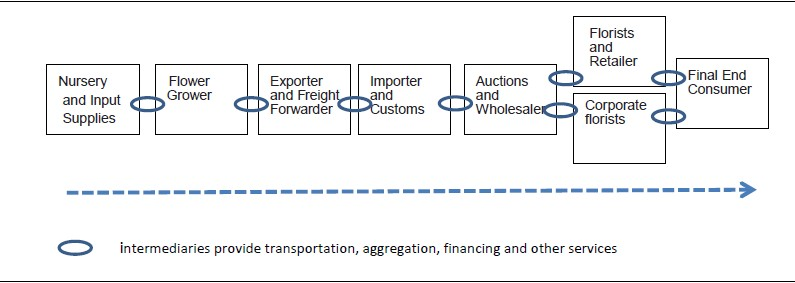Introduction
The reason for growing flowers and other floricultural crops is to deliver a first rate, quality product that appeals to the consumer, is value for money and encourages repeat sales. Doing this successfully helps the grower earn a living and achieve a fair return on capital invested.
Ultimately the market is the consumer. The flower product will need to appeal to consumers as they browse retail outlets or catalogues.
There are many stages between the grower and consumer — wholesalers, exporters, auctioneers, florists or supermarket buyers and the local shop. Each will have specific requirements but all are trying to entice the consumers to spend their money on flowers.
As a grower, you will deal with parts of this chain depending on your circumstances, but the requirements are very much the same.

Global market
Not only is it a global market but the competition is strong. Flowers are grown around the world and often in countries with lower cost structures or closer to our main markets.
Western Australian producers can only compete if their product stands out from the crowd in terms of quality, presentation and uniqueness. However, it still has to represent good value for money.
How to compete
We need to make sure we:
- research and plan the mix of varieties that are going to achieve good returns
- grow these to match stem length and disease/insect-free status requirements (particularly for export markets)
- schedule to flower or produce (foliages) at the right time
- pick at the right stage avoiding old flowers as these will only detract from the fresh flowers
- immediately place them in water to hold their temperature and moisture
- pick in early morning, especially during summer
- keep them in the shade or in an insulated vehicle
- get them to the packing shed fast
- treat/disinfect flowers carefully to ensure insect-free status, pulse or treat with preservatives, sugar or appropriate treatment or anti-ethylene pre-treatment if flowers are ethylene sensitive
- trim to a uniform length, grade to uniform lines in both colour, size and shape
- place flowers in the right size sleeve/carton; cool rapidly to 2°C and move to the market in insulated or refrigerated trucks — holding temperature around 2°C
- transfer the flowers immediately to the wholesaler/exporter/florist’s coolroom
- distribute the flowers to florists/retail outlets/consumers in insulated or refrigerated trucks or vans
- ensure that the exporter transfers the flowers from their warehouse to the overseas consumer quickly and directly while maintaining cool temperatures.
At each stage, you need to ensure the product is uniform. One poor flower will discount the whole lot.
Labelling bunches with varietal names or giving different wrapping to a specific florist may help create loyalty. Product branding works to create loyalty — this can be on a state basis or by an individual exporter or grower.


